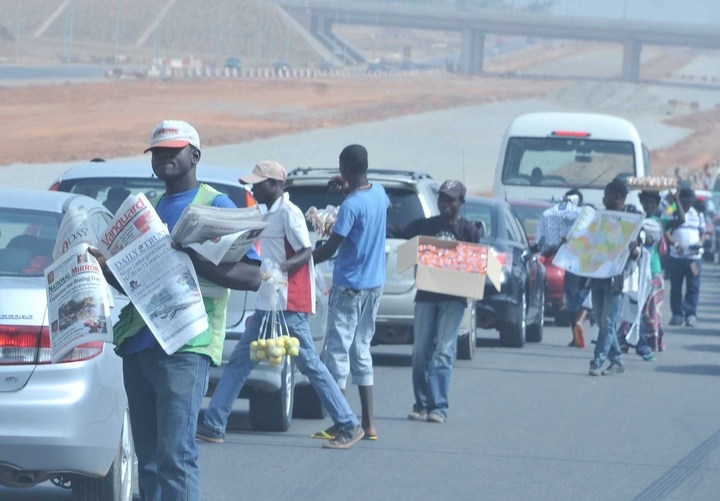
Many scholars have written seminal articles on the growing phenomenon of street hawking in major cities of the country. As the country’s middle class begins to expand, the quest for survival by the deprived and marginalized in the society has pushed many jobless young ones into the streets.
Street hawking was in the past restricted to the central business districts of Accra, Kejetia and the Adum areas in Kumasi as well as some few travellers’ stops on some major highways in the country. Kpong, Atimpoku, Nsawam, all in the Eastern and Winneba Junction are good examples. There, travellers are treated to their favourite locally prepared oyster kebabs, lobsters, bread and other interesting dishes made from bush meat and more.
Independent Perspectives
Owusu and Abrokwah, two researchers at the University of Ghana in a very revealing research article indicated that street hawking has both spatial and temporal dynamics that make hawking more complex than is observed.
The researchers pointed out that to the street hawker, hawking is a means of eking out a living, but to the city elites and policy makers, street hawking is a menace that must be stopped either by fair or foul means.
According to the researchers, while the authorities plan to evict by all means necessary, hawkers’ game plan is to stay and maximize daily profit by all means – hence the emergence of make-shift hawking patterns and eviction strategies characterized by brutalities and prosecution. The authors of the report narrated how these two giants have put the general public in a fix, the public needing clean and less congested city streets, yet hawkers and their dependents must also survive.
But street hawking is beginning to take an interestingly dangerous dimension where hawkers are now competing with drivers and other road users in the cities. Accra alone is estimated to be host to some four million people. Kumasi comes in second with an estimated population of about three million. The population of Ghana’s twin oil city of Sekondi-Takoradi is also growing very fast, thanks to an increasing expatriate and local working class moving in to feed the oil and allied industries.
The University of Ghana researchers pointed at four obvious but critical causes of street hawking. Our cities’ gridlocked traffic conditions, profitability, lack of employable skills and minimal capital requirement for starting the hawking trade.
Policy failure
Prof Peter Quartey, head of the Department of Economics at the University of Ghana describes street hawking as a developing country phenomenon. The respected Economist says there is aggressive street hawking in Nigeria, Ethiopia, Kenya and other developing nations but attributes the haphazard street hawking in Ghana to the typical general policy failure.
He believes the form street hawking has taken is not something the nation should encourage at all. There is caravan and car boot sales in advanced countries. Sunday and Saturday markets are also created and permits given to hawkers to set up tents and sell in the streets and the mess is cleared immediately afterwards.
In the some advanced countries, Saturday and Sunday markets or hawkers’ markets are created where streets are closed for brief periods for vendors to display their wares for members of the public to patronize. Here, taxes are paid and the process is very well controlled – there are three beneficiaries here, the state benefits through tax revenue, members of the public also shop around for whatever they want from the hawkers and the sellers also makes their money.
Prof Quartey calls for proper regulation by the authorities as is done in Finland, United Kingdom, and the United States of America while at the same time educating our people about the hazards of uncontrolled hawking. The authorities can also take another look at reviving the abandoned Odawna Hawkers’ Market at the Kwame Nkrumah Circle.
The whole place can be remodeled and allocated to hawkers. Otherwise, the mess that would accompany the Nkrumah Circle area upon the completion of the new overhead bridge would be uncontrollable as the hawkers would definitely want to find spaces to ply their trade.
These days the hawkers mingle precariously with vehicular traffic on the major streets. Sometimes, if a driver is not extra careful, one could easily run into hawkers who race through the traffic with their wares dangling on their heads in a bid to beat one another to make daily living.
In 2008 eight hawkers were knocked down and killed at the Kaneshie traffic lights area in Accra when a passenger vehicle lost control and run into the hawkers. The lives of hawkers have become ever more dangerous on the streets with the growing menace of motorbike transportation popularly called ‘Okada’.
The earlier the authorities revisit the concept of the Odawna Hawkers’ Market and replicate the model in other city centres while ensuring strict compliance to the by-laws on street hawking, the better.
Author: Maximus Attah, Lecturer, GIJ | attafynn@gmail.com









